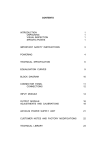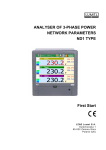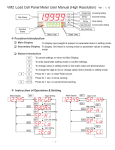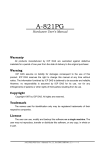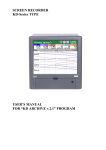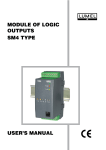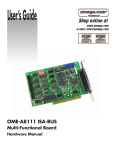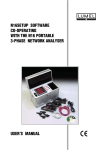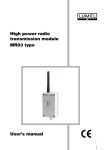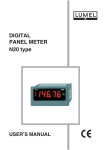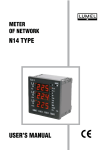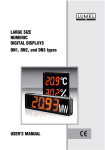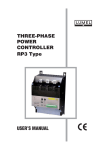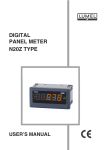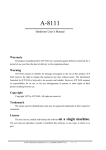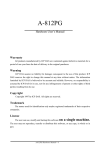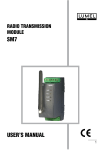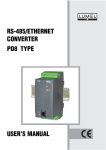Download SMC PROGRAMMABLE LOGIC CONTROLLER
Transcript
PROGRAMMABLE LOGIC CONTROLLER SMC TYPU USER’S MANUAL 2 CONTENTS 1. 2. 3. 4. APPLICATION AND DESIGN SET OF THE DELIVERED CONTROLLER BASIC REQUIREMENTS AND SAFETY SERVICE DESCRIPTION OF THE DESIGN AND INSTALLATION 4.1. Design Description 4.2. Terminal Description 4.3. Installing COM Port for Windows 4.4. Installing COM Port Controllers in the Computer 5. CONTROLLER CONFIGURATION 5.1. Connection PC <--> SMC 5.2. SMC Communication <-> Devices (SM modules) 5.3. Writing the Program in SMC 6. DESCRIPTION OF THE TRANSMISSION PROTOCOL FUNCTIONS 6.1 Readout of n-registers (Code 03) 6.2. Writing Values in the Register (Code 06) 6.3. Writing in n-registers (Code 16) 6.4. Identifying Report of the Device (Code 17) 7. ERROR CODES 8. TECHNICAL DATA 9. ORDERING CODES 10. MAINTENANCE AND GUARANTEE 4 4 5 6 6 7 8 8 9 9 12 17 18 18 18 19 19 19 20 22 23 3 1. APPLICATION AND DESIGN The SMC programmable logic controller is the central decision module in distributed measuring and control systems with a quick MODBUS communication (up to 115.2 kbit/s). It can service remote analogue and logic input/output modules, measuring transducers, inverters, microcontrollers, recorders, display panels, HMI touch screen panels, etc. Thanks to the integration of various devices we can obtain a versatile and flexible dissipated system with a large application range. ▪ The SMC controller is programmed in the ST (Structured Text) language acc. to IEC 61131-3 standard. The ST language is the most versatile from among IEC languages and allows the implementation of any types of algorithms. ▪ The CPDev (control Program Developer) tool package, consisting of the CPDev compiler, CPSim program simulator, and CPCon communication configuration, serves for the SMC programming. ▪ The package includes libraries: IEC_61131, Basic_blocks and Complex_blocks. ▪ The system designer can create own libraries with functions, functional blocks and programs. ▪ Two serial ports are destined for communication. Port 1 with two RS-485 interface systems for the communication with devices working in the object. Port 2 with RS-485, RS-232C and USB interfaces for the communication with the Master system through wire links. ▪ The asynchronous character communication MODBUS protocol is implemented in ports. Parameter set of the SMC controller serial link: - address: 1...247 1200, 2400, 4800, 9600, 19200, 38400, 57600, 115200 bit/s, - baud rate: - working mode : ASCII: 8N1, 7E1, 7O1, 7N2 RTU: 8N2, 8E1, 8O1, 8N1 Exemplary network topology with the use of controllers is shown on the Fig.1, SMC RS485 RS485 RS232 SMC RS485 Fig. 1. Exemplary network topology with the application of SMC controllers 2. SET OF THE DELIVERED CONTROLLER The SMC controller set includes: - SMC controller 1 pc - SMC user’s manual 1 pc - programming user’s manual 1 pc - guarantee card 1 pc - CD disk with the tool program 1 pc and controllers of the USB port When unpacking the SMC controller, please check whether the type and version code on the data plate correspond to the order code. 4 3. BASIC REQUIREMENTS, SAFETY SERVICE Symbols located in this user’s manual mean: WARNING! Warning of potential, hazardous situations. Especially important. One must acquaint with this before connecting the SMC controller. The non-observance of notices marked by these symbols can occasion the damage of the instrument. CAUTION! Designates a general useful note. If you observe it, handling of the controller is made easier. One must take note of this, when the instrument is working inconsistently to the expectations. Possible consequences if disregarded ! Note: The removal of the controller housing during the guarantee contract period causes its cancellation. In the security scope the controller meets the requirements of the EN 61010 -1 standard. Remarks Concerning the Operator Safety Service: ▪ All operations concerning transport, installation, and commissioning as well as maintenance, must be carried out by qualified, skilled personnel, and national regulations for the prevention of accidents must be observed. ▪ Before switching the controller on, one must check the correctness of connection to the network. ▪ Do not connect the controller to the network through an autotransformer. ▪ Before removing the controller housing, one must switch the supply off and disconnect measuring circuits. ▪ One must remember that in the building installation a switch or a circuit-breaker should be installed. This switch should be located near the device, easy accessible by the operator, and suitably marked 5 4. DESCRIPTION OF THE DESIGN AND INSTALLATION 4.1. Design Description The SMC controller is destined to be fixed on a 35 mm rail support (acc. to EN 60715) in the way shown on the fig. 2. SMC Fig. 2. Fixing way of the SMC controller 6 4.2. Terminal Description The supply and external signals must be connected in accordance with the fig. 3. Individual outlets have been described in the table 1. Caution: One must pay a particular attention on the correct connection of external signals (see table 1) SMC There are 3 signalling diodes on the frontal plate D1 Two-colour diodes. Green colour – continuous lighting – signals a correct controller work. Green colour – pulsating – signals the work in the configuration mode. Red colour – signals a configuration error. D2 Green diode Signals the data transmission from the side of a slave device type. D3 Yellow diode Signals the data transmission from the side of a master device type. Table 1. Description of SMC Controller Outlets USB socket Terminal 1 2 3 4 5 6 7 8 9, 10 11 12 13 14 15 16 Terminal description Output +5 V ( for bus bias) Line A of the first RS-485 interface of Port 1 Line B of the first RS-485 interface of Port 1 Line GND of the RS-485 interface of Port 1 Line GND of the RS-485 interface of Port 1 Line B of the second RS-485 interface of Port 1 Line B of the second RS-485 interface of Port 1 Output + 5V (for bus bias). Lines of controller supply Not used Output TxD of the RS-232 interface of Port 2 Input RxD of the RS-232 interface of Port 2 Line GND of the RS-232 and RS-485 interfaces of Port 2 Line A of the RS485 interface of Port 2 Line B of the RS-485 interface of Port 2 Fig. 3. Electrical connections of the SMC controller. The controller has two serial ports, Port 1 and Port 2. The port 1 is destined for communication with devices of Slave type. Two RS-485 interface systems are added to the Port 1. The operation of both systems is identical. Interface systems are electrically connected and galvanically isolated from the remainder of the system. Interface lines are connected to terminals 1, 2, 3, 4 for the first port, and 5, 6 , 7 , 8 for the second port. The RS-485 bus enables the direct connection to 32 devices with RS-485 interface. The maximal bus length depends on the baud rate and is included in limits from several dozens of meters for high speeds, up to ca 1.2 km for low speeds. The port 2 is destined for the controller configuration with the PC computer. The Port 2 includes RS-485, RS-232 and USB interfaces. The RS-485 interface enables the connection of the controller to the RS-485 serial bus, its lines has been led out to terminals 14, 15 and 16. RS-232 and USB interfaces are destined to connect with the Master system. 7 The RS-232 interface signals are led out to terminals 12, 13 and 14. The USB interface is available on the controller frontal plate. RS-485, RS-232 and USB interfaces are connected to the Port 2 and cannot be used simultaneously. The current program on a CD is included in the controller set. The current programming package for SMC is included on the www.lumel.com.pl/download page. All updatings can be carried out by means of the programming package runs on this page. The tool package CPDev (Control Program Developer) serves to program the SMC controller. It is composed of: - compiler CPDev, - program simulator CPSim - communication configurer CPCon. Three libraries complete the package - IEC_61131, Basic_blocks and Complex_blocks. 4.3. Installing COM Port for Windows The controller USB Port takes advantage of the program which is created in the system by the new USB Serial Converter device and the Port (Com) assigned to him – USB Serial Port. The installation of the controller in the Windows system causes the addition of a successive serial COM Port to the list of ports serviced by the operating system. 4.4. Installing COM Port Controllers in the Computer. On the CD added to the product, there are catalogues with controllers for following operating systems: - WIN_XP: Windows 2000, Windows XP, Windows Vista, Windows Server 2003. - WIN_XP_64: Windows Vista x64, Windows XP x64, Windows Server 2003 x64. NOTE: Controllers do not co-operate with Windows 98 and ME systems. Installation in Windows 2000, Windows XP, Windows Vista and Windows Server 2003 systems. In order to install controllers for these systems, one must start the program realizable from the catalogue with the controller for the given system: - WIN_XP\CDM_Setup.exe (for Windows 2000, Windows XP, Windows Vista and Windows Server 2003) - WIN_XP_64\ CDM_x64_Setup.exe (for Windows XP x64, Windows Vista x64 and Windows Server 2003 x64). This program will install controllers for new devices and ports in the system. Next, one must connect the controller, which will be found and identified by the system, as USB serial converter, and the Port (Com) will be assigned to it – USB Serial Port. 8 5. CONTROLLER CONFIGURATION NOTE : The language description and examples of controller programming are included in the programming manual. Before proceeding to the controller configuration, one must prepare the controlling program taking advantage of tools included in the controller set. 5.1. PC SMC Connection 5.1.1 Installation of the USB Controller If the PC computer has not an installed USB port controller for the SMC, one must install it through the CDM_Setup.exe program from the CD acc. to the section 4.4. It generates, that the USB port will be serviced as a serial port. PC↔SMC Cable Connect the USB port of the computer to the USB port of the SMC controller (on the frontal plate). 5.1.2 Number of the USB Port Read out in the Device Manager of the Windows system, which COM port is the USB port connected to the SMC controller. • Menu Start > Settings > Control panel > System > Hardware > Device Manager In the appearing window, develop Ports: In the case like above, USB is the COM5 port. 5.1.3 Starting the CPCon configurer One can start the configurer in three ways: a) Menu CPDev: Project > Run the configurer Fig.4. Starting the configurer from the Project Menu. 9 b) Tools > Configurer Fig. 5. Starting the configurer as tools c) Menu start: CPDeV > CPCon Fig. 6 Starting the configurer from the system menu The first way is applied directly after the Project compilation. The two next require the file import from the compiled project. After starting, the configuration window of the CPCon communication appears Fig. 7. Table of communication tasks The communication task table has a basic meaning. It defines which transactions of the MODBUS protocol, i.e. exchange of messages queries – responses (readout) or commands – confirmation (write) will take place. Transactions are named here communication tasks. 10 5.1.4 Menu CPCon Fig. 8. File menu of the CPCon program Fig. 9. Transmission menu of the CPCon program Buttons under the table (Fig. 7) realizes a part of functions given in options. The project file import is necessary, when CPCon was started in the second or third way. The read out metric contains documentation data of the carried out program by the controller. The synchronization sets the controller clock acc. to the computer. 5.1.5 Transmission Settings • Transmission > Settings The Settings window with Communication tags, Program Settings and Update, appear in the window. • Vertical communication The Tag serves to set PC ↔ SMC communication parameters. The port number issues from the Device Manager of the PC computer. Fig. 10. Setting of the PC ↔ SMC communication 11 • Horizontal communication Communication parameters SMC ↔ in/out modules can be selected from the tag (or other devices). Parameters must be the same as they set in modules. The 8N1 mode selected below means 8-bit data, odd parity (N) and 1 stop bit. Fig. 11. Setting of the PC SMC in/out module communication • Program Setting Language selection. Fig. 12. Language setting 5.2 SMC Communication Devices (SM Modules) For the SMC controller communication with object devices can serve : a) global variables, which addresses, e.g. START, STOP, ALARM, have been assigned to, b) COM_SM1, COM_SM2, etc, communication blocks, dedicated for SM module. The communication is configured by fulfilling a suitable number of rows of the task table. Each line represents one communication task of the SMC controller. The filling can me made directly from the table (the right mouse key adds or erases the row, or by means of the task creator (button) composed of several windows: 12 • Press the button in the program window. The creator information window appears Fig. 13. Creator of communication tasks 5.2.1 Device Number. MODBUS Function • Input devices (e.g. SM5) can be read out by groups by means of the function with Code 3 (readout of registers , named FC3 here (Function Code 3). The first window can have the shape like below. Fig. 14. Definition of the target slave number and the readout function 5.2.2 Variables. Addresses • The list of global variables with addresses appears in the creator window. Fig. 15. Assignment of global variables to the device. 13 Among global variables of our project, we highlight input variables. The logic addresses of variables are e.g. 0,1, 2, and the dimension of each is a byte. Addresses of input variables are successive numbers, then the readout by groups (by blocks) is suitable. Note. If the list is empty, then the click of the (write the variables list in) allows to import variables from the chosen file in the being opened window. 5.2.3 Device. Beginning Address. • Example of the SM5 module device association for communication tasks. For example, the START variable register has the address 4003. Fig. 16. Assignment to the device and definition of the beginning address. 5.2.4 Priority. Timeout Communication tasks defined by type lines of the main table are made in breaks, which after performing the program time remains to the end of each cycle. If the break is important, the task can be carried out several times. The task with a normal priority is carried out twice rarely than the task with a high priority, and the task with a low priority, three times rarely. Timeout means the maximal period of time during which the exchange of messages with the device has to be finished. • It is assumed that the communication task from SM5 will have a normal priority and the exchange of messages has to be finished during 500 ms (timeout). Fig. 17. Assignment of the priority and waiting time. 14 5.2.5. Control Variables The last creator window serves for the configuration of transmission control, if the appropriate fragment of the program forecasts it. It is indicated in the window, to which of variables has to be write the information about the correctness or incorrectness of the communication, which of the variable is destined to write the communication time in, and by means of which, one can enable or disable communication tasks. Control variables are used in advanced projects. Fig. 18. Control variables 5.2.6 Creation of the Communication Task • Press the button . The first line with data set in the creator appears in the table of communication tasks and with it, the conversion of registers into bytes, 16 → 8 bit. Fig. 19. View of the table after the task configuration. 15 5.2.7. Direct Filling of the Table (alternative for the Creator). Addition and elimination of the row – right Mouse key Function code, kind of conversion, priority – selection from the menu. Other cells – written in the ordinary way. 5.2.8. Writing the Configuration into the File. The table of communication tasks can be utilized in later modifications or in other Projects. The file with the table is also indispensable when the CPSim Simulator has to stimulate the operation of devices added to the controller. The CPCon configurer write files with the XMC extension. • Press the button The window Write file with the configuration of the communication subsystem appears, in which one must write the file name, e.g. Start_Stop.xmc (XMC extension added automatically). Fig. 20 Writing the project to the file 16 5.2.9. Configuration Readout ( for Check, Modification, ETC.) • Press the button Select the file in the appearing window Open file with the confirmation of the communication subsystem and click Open. Fig. 21 Reading in the project to the file In case of the file Start_Stop.xmc, the table of communication tasks will be looked like previously. 5.3 Writing the Program in SMC • Before writing, it is worth to open the lower part of the window by clicking Communication monitoring. It allows to check if the write has proceeded correctly. • Press the button • The window of the project specification (metric) appears, which with the program will be written in the SMC controller. During the write, check information is displayed in the Communication monitoring window. Fig. 22. Exemplary communication window PC SMC After writing the program, the SMC controller begins instantly its execution, communicating with object devices. 17 6. DESCRIPTION OF THE TRANSMISSION PROTOCOL FUNCTIONS Following functions of the MODBUS protocol were implemented in the controller. code 03 06 16 17 Meaning Readout of n-registers Write of a single register Write of n-registers Identification of the slave device 6.1. Readout of n-registers (code 03) Request: The function enables the readout of values included in register, in the addressed slave device. Registers are 16 or 32-bit units, which can include numerical values related to process variables a.s.l. The request frame is defined by the first 16-bit address of the register and the number of registers to readout. The meaning of the register contents about given addresses can be different for different device types. The function is not available in the broadcast mode. Example: Readout of 3 registers beginning from the register with 6B h address. address function 11 03 register address Hi 00 register address Lo 6B number of number of checksum registers registers Hi Lo 00 03 7E LRC Response: Register data are packed beginning from the lowest address: first the older byte, next the younger register byte. Example: Response frame. address function numb. value of value of of reg.107 reg.107 bytes Hi Lo 11 03 06 02 2B 6.2. value in reg.108 Hi 00 value in reg.108 Lo 00 value in reg.109 Hi 00 value in checksum reg.109 a Lo 64 55 LR C Writing the Value in the Register (Code 06) Request: The function enables the modification of the register contents. It is available in the broadcast mode. Example: address function register register value value checksum address address Hi Lo Hi Lo 11 06 00 87 03 9E C1 LRC Response: The correct response for the request of the value write in the register is the message retransmission after performing the operation. Example: address function register register value value checksum address address Hi Lo Hi Lo 11 06 00 87 03 9E C1 LRC 18 6.3. Writing in n-registers (Code 16) Request: The function is available In the broadcast mode. It enables the modification of the register contents. Example: Write of two registers beginning from the register with the address 136. address funct. regist. regist. numb. numb. numb. data data data data checkaddress address of reg. of reg. of Hi Lo Hi Lo sum Hi Lo Hi Lo bytes 11 10 00 87 00 02 04 00 0A 01 02 45 LRC Response: The correct response includes the slave unit address, initial address and the number of written addresses. Example: address function register register number number checksum address address of registers of registers Hi Lo Hi Lo 11 10 00 87 00 02 56 LRC 6.4. Report Identifying the Device (Code 17) Request: The function allows the user to obtain information about the device type, status and configuration depending on it. Example: address function 11 11 checksum DE LRC Response: The field „Device identifier” in the response frame means the unique identifier of the given device class, however remaining fields include parameters dependent on the device type. 7. ERROR CODES When the master device transmits the request to the slave device then, with the exception of messages in the broadcast mode, it waits for a correct response. After transmitting the request of the master unit, one of the four possible events can appear: If the slave unit receives the request without a transmission error and can perform it correctly, then returns the correct response. If the slave unit does not receive the request, not any response is returned. In the program of the master device, timeout conditions will be fulfilled for the request. If the slave unit receives the request, but with transmission errors (parity error, LRC or CRC checksum), not any response is returned. Timeout conditions for request will be fulfilled in the master device program. If the slave unit receives the request without transmission errors, but cannot perform it correctly (e.g. If the request is a readout of a not existing bit output or register), then returns the response including the error code, informing the master device about the error cause. The message with an erroneous response includes two fields differentiating it from the correct response.: Function Code Field: In the correct response, the slave unit retransmits the function code from the request message on the response code field. All function codes have the most significant bit (MSB) equal 0 ( code values are below 80h). In the erroneous terror, the slave device set the MSB bit of the function code on 1. This occasions, that the function code value in the erroneous response is exactly higher of 80h than it had been in the correct response. On the base of the function code with the set MSB bit, the master device program can begin the erroneous response and check the error code in the data field. 19 Data Field: In the correct response, the slave device can return data on the data field (some information requested by the master unit). In the erroneous response, the slave device returns the terror code on the data field. It defines the slave device conditions, which causes the error. An example of master device request and erroneous slave device response is presented below. Data are in the hexadecimal shape. Example: request slave address function 0A 01 variable address Hi 04 variable address Lo A1 number of variables Hi 00 number of variables Lo 01 checksum 4F LRC Example: erroneous error slave address 0A function 81 error code 01 checksum 73 LRC In this example, the master device addresses the request to the slave unit numbered 10 (oHa). The function with the code (01) is not implemented in the concentrator, then the device returns the erroneous response with the error code nr 01. It indicates the forbidden function in the slave device. Possible error codes and their meanings are presented in the table below. code 01 02 03 04 05 meaning forbidden function forbidden data address forbidden data value request being in realization impossible request realization 8. TECHNICAL DATA Serial port I: - baud rate 1200, 2400, 4800, 9600, 19200, 38400, 57600, 115200 bit/s - mode ASCII: 8N1, 7E1, 7O1,7N2 RTU: 8N2, 8 E1, 8O1, 8N1 - interface 2 x RS-485 Serial port II: - baud rate 1200, 2400, 4800, 9600, 19200, 38400, 57600, 115200 bit/s - mode ASCII: 8N1, 7E1, 7O1,7N2 RTU: 8N2, 8 E1, 8O1, 8N1 - interface RS-485, RS-232 USB 1.1 – wire no longer than 3 m Transmission protocol: MODBUS – ASCII, RTU Power consumption ≤ 4 VA 20 Rated operating conditions: - supply voltage - supply voltage frequency - ambient temperature - relative air humidity - external magnetic field - working position Storage and transport conditions: - ambient temperature - relative air humidity 20…24…40 V a.c./d.c. or 85…230…253 V a.c./d.c. 40…50/60…440 Hz 0…23…55ºC < 95% (inadmissible condensation of water vapor) < 400 A/m any -20…70 ºC < 95% (inadmissible condensation of water vapor) Ensured protection levels: - from frontal housing side - from terminal side IP 40 IP 20 Overall dimensions: 45 x 120 x 100 mm Weight : 0.25 kg SMC casing: for mounting on a 35 mm DIN rail Electromagnetic compatibility: - noise immunity - noise emissions acc. to EN 61000-6-2 acc. to EN 61000-6-4 Safety requirements acc. to EN 61010-1: - installation category - pollution level III 2 Maximal phase-to-earth working voltage: - for supply circuits - for other circuits 300 V 50 V 21 9. ORDERING CODES SMC- PROGRAMMABLE CONTROLLER X 85…253 V a.c/d.c. 1 20…40 V a.c/d.c. 2 XX X X Supply voltage: Version: standard 00 non-standard settings NS custom-made* XX Polish P English E other X Language: without extra l requirements Acceptance tests: 0 with an extra quality inspection certificate 1 acc. to customer’s request * X * After agreeing with the manufacturer ORDERING EXAMPLE The code: SMC-1- 00- E-1 means: SMC – programmable controller of SMC type 1 – supply voltage: 85…253 V a.c./d.c. 00 – standard version E – English language 1 – delivered with an extra quality inspection certificate 22 10. MAINTENANCE AND GUARANTEE The applied battery in the SMC controller requires replacement every 5 years. In order to replace the battery, one must send the controller to the Manufacturer’s Service Department. In case of some incorrect operations: 1. In the period given in the annexed guarantee card One should take the controller down from the installation and return it to the Manufacturer’s Quality Control Dept. If the unit has been used in compliance with the instructions, the Manufacturer guarantees to repair it free of charge. 2. After the guarantee period: One should turn over the controller to repair it in a certified service workshop. The disassembling of the housing causes the cancellation of the granted guarantee. Our policy is one of continuous improvement and we reserve the right to make changes in design and specifications of any products as engineering advances or necessity requires and revise the above specifications without notice. 23 CONTROL MEASUREMENT RECORDING SALES PROGRAM DIGITAL AND BARGRAPH PANEL METERS MEASURING TRANSDUCERS ANALOG PANEL METERS (DIN INSTRUMENTS) DIGITAL CLAMP-ON METERS INDUSTRIAL PROCESS CONTROLLERS CHART AND PAPERLESS RECORDERS POWER CONTROL UNITS AND SOLIDE-STATE RELAYS ELECTRONIC WATT-HOUR METERS ▪ INTEGRATION ELEMENTS OF MEASURING NETWORKS ▪ LARGE-SIZE ALPHANUMERICAL DISPLAY PANELS ACCESSORIES FOR MEASURING INSTRUMENTS ( SHUNTS) CUSTOM - MADE PRODUCTS WE ALSO OFFER OUR SERVICES IN THE PRODUCTION OF: ALUMINIUM ALLOY PRESSURE CASTINGS PRECISION ENGINEERING AND THERMOPLASTICS PARTS SMT ASSEMBLY SERVICES MOUNTING OF SUBCONTRACTED ELECTRONIC DEVICES QUALITY PROCEDURES: According to ISO 9001 and ISO 14001 international requirements. All our instruments have CE mark . For more information, please write to or phone our Export Department SMC-09/1 January 2010 Lubuskie Zakłady Aparatów Elektrycznych - LUMEL S.A. ul. Sulechowska 1 65-022 Zielona Góra – Poland Export Department: Tel.: (48-68) 32 95 1 00 (exchange) Fax: (48-68) 32 95 1 01 Tel.: (48-68) 329 53 02 Fax: (48-68) 325 40 91 e-mail:[email protected] http://www.lumel.com.pl e-mail: [email protected] 24
























